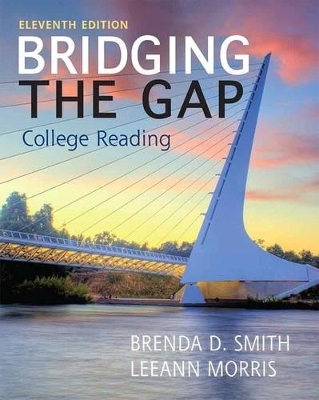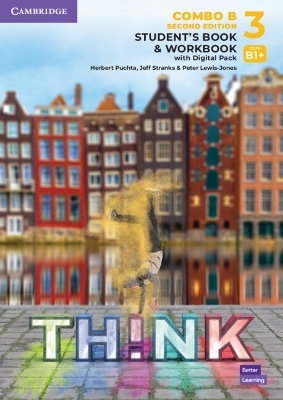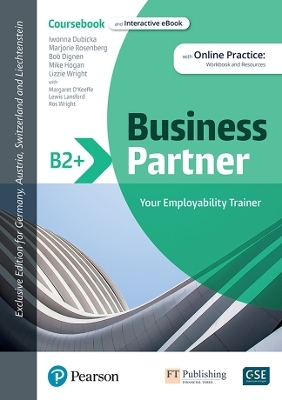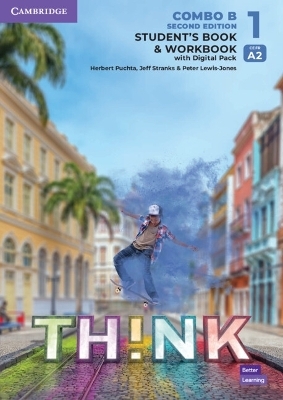
Bridging the Gap with NEW MyReadingLab with eText -- Access Card Package
Longman Inc
978-0-321-88166-3 (ISBN)
- Titel ist leider vergriffen;
keine Neuauflage - Artikel merken
Packages
Access codes for Pearson's MyLab & Mastering products may not be included when purchasing or renting from companies other than Pearson; check with the seller before completing your purchase.
Used or rental books
If you rent or purchase a used book with an access code, the access code may have been redeemed previously and you may have to purchase a new access code.
Access codes
Access codes that are purchased from sellers other than Pearson carry a higher risk of being either the wrong ISBN or a previously redeemed code. Check with the seller prior to purchase.
--
Brenda Smith’s Bridging the Gap was the first college reading text to focus on reading for college, and through its eleven editions has been the most popular textbook choice of developmental reading educators.
0321881664 / 9780321881663 Bridging the Gap with NEW MyReadingLab with eText -- Access Card Package
Package consists of:
0205852068 / 9780205852062 Bridging the Gap
0205869165 / 9780205869169 NEW MyReadingLab with Pearson eText -- Valuepack Access Card
LeeAnn Morris Bio Dr. LeeAnn Morris has over 20 years of community college teaching experience and is committed to helping students achieve their college and career goals. She takes great satisfaction in continuing Brenda Smith’s legacy of excellence by shepherding Breaking Through: College Reading through its 9th and 10th editions and Bridging the Gap: College Reading through its 10th and soon to be published 11th editions. LeeAnn is a Distinguished Faculty professor at San Jacinto College near Houston and has been honored there with the Outstanding Faculty Award. She served as chair of the College Preparatory Department and is delighted to return to the classroom fulltime this fall to teach two levels of integrated reading and writing courses. LeeAnn is an avid reader and believer in the power and pleasure of lifelong reading. She has done extensive research on reading workshop approaches for college developmental reading students. She has witnessed the satisfaction and growth that come from reading often and widely and has incorporated the reading workshop concept into her teaching and into Breaking Through and Bridging the Gap.
Preface
An Overview of Bridging the Gap
Chapter 1: Active Learning
What is Active Learning?
What Are Cognitive Psychology and Neuroscience?
How Does the Brain Screen Messages?
Brain Boosters
Brain Boosters: Are You Paying Attention?
Cognitive Styles
Cognitive Style Preferences
Global Versus Analytical
Sensory Learning Styles
Multiple Intelligences: There Is More Than One Way to Be Smart
What If I’m Not a Verbal or Logical Learner?
What is Concentration?
Poor Concentration: Cause and Cures
External Distractions
Internal Distractions
Brain Booster: Are You Curious?
Reader’s Tip: Improving Concentration
Successful Academic Behaviors
Reader’s Tip: Managing School and Work E-Mail
Summary Points
MyReadingLab
The Reading Workshop
SECTION 1: PSYCHOLOGY
Video: “Creativity”
“Becoming More Creative” By Carol Wade and Carol Tavris
Concept Prep for Psychology
SECTION 2: HISTORY
“Home Front Workers, Rosie the Riveter, and Victory Girls” by Jacqueline Jones, et al
Concept Prep for History
SECTION 3: ENVIRONMENTAL SCIENCE
“Volunteers Help protect the Environment” from www.peacecorps.gov
Chapter 2: Vocabulary
Remembering New Words
Brain Booster: Use Your Senses to Make More Sense!
Associate Words in Phrases
Associate Words with Rhymes or Sounds
Associate Words with Images
Associate Words in Families
Seek Reinforcement
Create Concept Cards
Using Context Clues
Definition or Synonym
Elaborating Details
Examples
Comparison
Contrast
Antonyms
Limitations of Context Clues
Multiple Meanings of a Word
Understanding the Structure of Words
Using a Dictionary
Using a Glossary
Using a Thesaurus
Brain Booster: Meaning Matters!
Word Origins
Using Analogies
Reader’s Tip: Categories of Analogy Relationships
Easily Confused Words
Recognizing Acronyms
Recognizing Transitional Words
Reader’s Tip: Types of Transitional Words
Summary Points
MyReadingLab
The Reading Workshop
Vocabulary Booster: Over, Under, Around, and Through
Chapter 3: Strategic Reading and Study
What is Strategic Reading?
Four Types of Readers
The Stages of Reading
Stage 1: Strategies for Previewing
Signposts for Previewing
Reader’s Tip: Asking Questions Before Reading
Preview to Activate Schemata
Brain Booster: Schemata and Your Brain
Stage 2: Strategies for Integrating Knowledge with Reading
Integrating Ideas: How Do Good Readers Think?
Reader’s Tip: Using Thinking Strategies While Reading
Metacognition
Reader’s Tip: Developing Metacognition for Reading
Stage 3: Strategies for Recalling
Recalling Through Writing
The Three Steps of Recalling
Reader’s Tip: Recalling After Reading
Brain Booster: Use It To Remember It!
Summary Points
MyReadingLab
The Reading Workshop
SECTION 1: HISTORY
“Madam C.J. Walker: Business Savvy To Generous Philanthropy” from America.gov Archive
SECTION 2: HEALTH
“High-Risk Drinking and College Students” by Rebecca Donatelle
SECTION 3: BUSINESS
Video: TOMS Shoes: Changing the World
“TOMS Shoes” Be The Change You Want to See In the World” by Gary Armstrong and Philip Kotler
Concept Prep For Business
Vocabulary Booster: The Good, the Bad, and the Ugly
Chapter 4: Main Idea
What is a Topic?
What is a Main Idea?
What are Supporting Details?
Distinguishing Topics, Main Ideas, and Details: A Closer Look
Strategies for Finding Main Idea
Prior Knowledge and Constructing the Main Idea
“Informed” Expert Readers
“Uninformed” Expert Readers
Identifying Main Ideas Among Sentences
Questioning for the Main Idea
Reader’s Tip: Using Questions for Find the Main Idea
Stated Main Ideas
The Topic Sentence
How Common Are Stated Main Ideas?
Where Are Stated Main Ideas Located?
What Are Major and Minor Details?
Reader’s Tip: Signals for Significance
Unstated Main Ideas
Unstated Main Ideas in Sentences
Unstated Main Ideas in Paragraphs
Interpreting the Main Idea of Longer Selections
Reader’s Tip: Getting the Main Idea of Longer Selections
Brain Booster: Brains Need the Right Amount Of Sleep
Summary Writing: A Main Idea Skill
Why Summarize?
Reader’s Tip: How to Summarize
Brain Booster: Chronic Stress and the Brain
Summary Points
MyReadingLab
The Reading Workshop
SELECTION 1: PHYSCHOLOGY
Video: The Effects of Stress
“Coping With Stress” by Carol Wade and Carol Tavris
Concept Prep for Psychology
SELECTION 2: SHORT STORY
“On the Sidewalk Bleeding” by Evan Hunter
Concept Prep for Literature
SELECTION 3: CRIMINAL JUSTICE
“Fighting Violent Gang Crime with Math” by Stuart Wolpert
Vocabulary Booster: Who’s Who in Medicine?
Chapter 5: Patterns of Organization
Textbook Organization: The Big Picture
What do Transitional Words Do?
Words That Signal Addition
Words That Signal Examples or Illustrations
Words That Signal Time or Sequence
Words That Signal Comparison
Words That Signal Contrast
Words That Signal Cause and Effect
Reader’s Tip: Signal Words for Transition
Patterns of Organization in Textbooks
Simple Listing
Definition
Brain Booster: Brains Like Patterns
Description
Time Order, Sequence, or Narration
Comparison
Contrast
Comparison and Contrast
Cause and Effect
Classification
Addition
Summary
Location or Spatial Order
Generalization and Examples
Reader’s Tip: Patterns of Organization and Signal Words
Clues to the Organizational Pattern
Brain Booster: Watering the Brain
Mixed Organizational Patterns
Summary Points
MyReadingLab
The Reading Workshop
SELECTION 1: NARRATIVE
“Instant Message, Instant Girlfriend” by Roger Hobs
SELECTION 2: HISTORY
“Women In History” by Leonard Pitt
Chapter 6: Organizing Textbook Information
The Demands of College Study
Building Knowledge Networks
The Study Process
Organizing Textbook Information
Brain Booster: Exercise to Boost Brain Power
Annotating
Why Annotate?
Reader’s Tip: How to Annotate
When to Annotate
Note Taking
The Cornell Method
Reader’s Tip: How to Take Notes: The Cornell Method
Outlining
Reader’s Tip: Guidelines for Successful Outlining
Brain Booster: Sleep and Problem Solving
Mapping
Reader’s Tip: How to Map
Summary Points
MyReaingLab
The Reading Workshop
SECTION 1: BUSINESS COMMUNICATIONS
“Watch Your Language” by Gary Armstrong and Philip Kotler
Concept Prep for Communications and Language
SECTION 2: HEALTH
“Nutrition, Health, and Stress” by Barbara Brehm
Concept Prep for Health
SECTION 3: CRIMINAL JUSTICE
Video: DNA and the Criminal Justice System
“Police DNA Collection Sparks Questions” by Carolyn Thompson
Vocabulary Booster: The Sun, The Moon, and The Stars
Chapter 7: Inference
What is an Inference?
What is Required to Make a Reasonable Inference?
Implied Meaning in Humor
Brain Booster: The Brain’s Pleasure Center and Learning
Connotative Language
Euphemisms and Politically Correct language
Figurative Language
Idioms
Similes
Metaphors
Literary Analogies
Hyperbole
Personification
Verbal Irony
Figurative Language in Poetry
More Types of Inferences
Inferences from Facts
Inferences About a Speaker or Narrator
Inferences Based on Action and Description
Using Prior Knowledge to Make Inferences
Brain Booster: Boost Brain Power Through Collaboration
Expanding Prior Knowledge
Drawing Conclusions
Reader’s Tip: Making Inferences
Summary Points
MyReadingLab
The Reading Workshop
SELECTION 1: SHORT STORY
“A Dip in the Poole” by Bill Pronzini
Concept Prep for Philosophy and Literature
SELECTION 2: SHORT STORY
“The Mountain Man” by Thaddeus Rutowski
SELECTION 3: PERSONAL NARRATIVE
Video: Illiteracy in the United States
“Fear the College Years” from The Teacher Who Couldn’t Read: A Memoir by John Corcoran
Concept Prep for Political Science
Vocabulary Booster: Can I Get That In Writing?
Chapter 8: Point of View
Textbooks and Author’s Point of View
What is the Author’s Point of View?
What is Bias?
What is the Reader’s Point of View?
Brain Booster: Male and Female Brains and Their Points of View
What Are Fact and Opinion?
Reader’s Tip: Questions to Uncover Bias
What is the Author’s Purpose?
What is the Author’s Tone?
Reader’s Tip: Recognizing an Author’s Tone
Point of View in Editorial Cartoons
Summary Points
MyReadingLab
The Reading Workshop
SELECTION 1: PHILOSOPHY
“Decision” by Gary Kirby and Jeffrey Goodpaster
SELECTION 2: SCIENCE
Video: Global Warming
“The Role of Humansin Global Warming” by Teresa Audesirk
SELECTION 3: HEALTH
“Steroids” by Rebecca J. Donatelle
Vocabulary Booster
Chapter 9: Critical Thinking
What is Thinking?
What is Critical Thinking
Critical Thinking Skills and College Goals
Reader’s Tip: Four Habits of Effective Critical Thinkers
Barriers to Critical Thinking
Recognizing an Argument
Steps in Analyzing and Evaluating and Argument
Step 1: Identify the Position on the Issue
Step 2: Identify the Support in the Argument
Step 3: Evaluate the Support
Reader’s Tip: Types of Support for Arguments
Step 4: Evaluate the Argument
Inductive and Deductive Reasoning
Applying the Four Steps of Critical Thinking
Explanation of the Four Steps
Creative and Critical Thinking
Brain Booster: The Creative Plan
Summary Points
MyReadingLab
The Reading Workshop
SELECTION 1: ESSAY
Video: The Magic Number of Beauty
“The Importance of being Beautiful” by Sidney Katz
SELECTION 2: ESSAY
“Give the Ref a Gavel” by Eldon L. Ham
SELECTION 3: ESSAY
“How Boys Become Men” by John Katz
Vocabulary Booster: Lights, Camera, Action!
Chapter 10: Graphic Illustrations
What Graphics Do
Reader’s Tip: How to Read Graphic Material
Diagrams
Tables
Maps
Pie Graphs
Bar Graphs
Line Graphs
Flowcharts
Summary Points
MyReadingLab
The Reading Workshop
SELECTION 1: PERSONAL NARRATIVE
“Little Income, Big Debt: Managing Money in College” by Trent Hamm
SELECTION 2: SCIENCE
Video: The American Diet
“The Risks and Benefits of Weight Loss Plans” by Campbell, et al.
SELECTION 3: SOCIOLOGY
“Technology and the Environment” by John J. Macionis
Vocabulary Booster: Play It Again, Sam
Chapter 11: Rate Flexibility
Why is Reading Rate Important?
What is Your Baseline Reading Rate?
Factors Affecting Reading Rate and Technique
Varying rate and technique to Fit Purpose
Rate Variations and Prior Knowledge
Brain Booster: Music to Our Ears and to Our Brains
Habits for Faster Reading
Concentrate
Stop Regressing
Expand Fixations
Stop Vocalizing
Preview
Use Your Pen as a Pacer
Push and Pace: Set a Time Goal
Skimming
Reader’s Tip: Techniques for Skimming
Scanning
Reader’s Tip: Techniques for Scanning
Summary Points
MyReadingLab
The Reading Workshop
Vocabulary Booster: Foreign Terms
Chapter 12: Test Taking
Can Being Test Wise Improve Your Score?
Brain Booster: Balance Memorization and Application in Test Preparation
General Strategies for Mental and Physical Preparation
Before Taking a Test
Reader’s Tip: Preparing For a Test
During the Test
After the Test
Brain Booster: Turn Mistakes into Success
Strategies for Standardized Reading Tests
Anticipate What is Coming Next
Read Rapidly, but Don’t Allow Yourself to Feel Rushed
Read to Learn and Enjoy
Self-Test for the Main Idea
Consider All Alternatives Before Choosing an Answer
Recognizing the Major Question Types on Reading Comprehension Tests
Main Idea Questions
Detail Questions
Inference Questions
Author’s Purpose Questions
Vocabulary Questions
Strategies for Content Exams
Multiple-Choice, True-False, and Matching Items
Short-Answer Items
Essay Questions
Reader’s Tip: Key Words in Essay Questions
Locus of Control
Summary Points
MyReadingLab
The Reading Workshop
Appendix 1: ESL: Making Sense of Figurative Language and Idions
Reader’s Tip: Categorizing Idioms
Appendix 2: The Reading Workshop: Topics and formats for Book Discussion
Glossary
Index
Photo Credits
Text Credits
An Overview of Concept Preps (Inside Front Cover)
Progress Chart for Reading Selections (Inside Rear Cover)
| Erscheint lt. Verlag | 28.2.2013 |
|---|---|
| Verlagsort | New Jersey |
| Sprache | englisch |
| Themenwelt | Schulbuch / Wörterbuch ► Wörterbuch / Fremdsprachen |
| Geisteswissenschaften ► Sprach- / Literaturwissenschaft ► Sprachwissenschaft | |
| Sozialwissenschaften ► Pädagogik | |
| ISBN-10 | 0-321-88166-4 / 0321881664 |
| ISBN-13 | 978-0-321-88166-3 / 9780321881663 |
| Zustand | Neuware |
| Haben Sie eine Frage zum Produkt? |
aus dem Bereich


